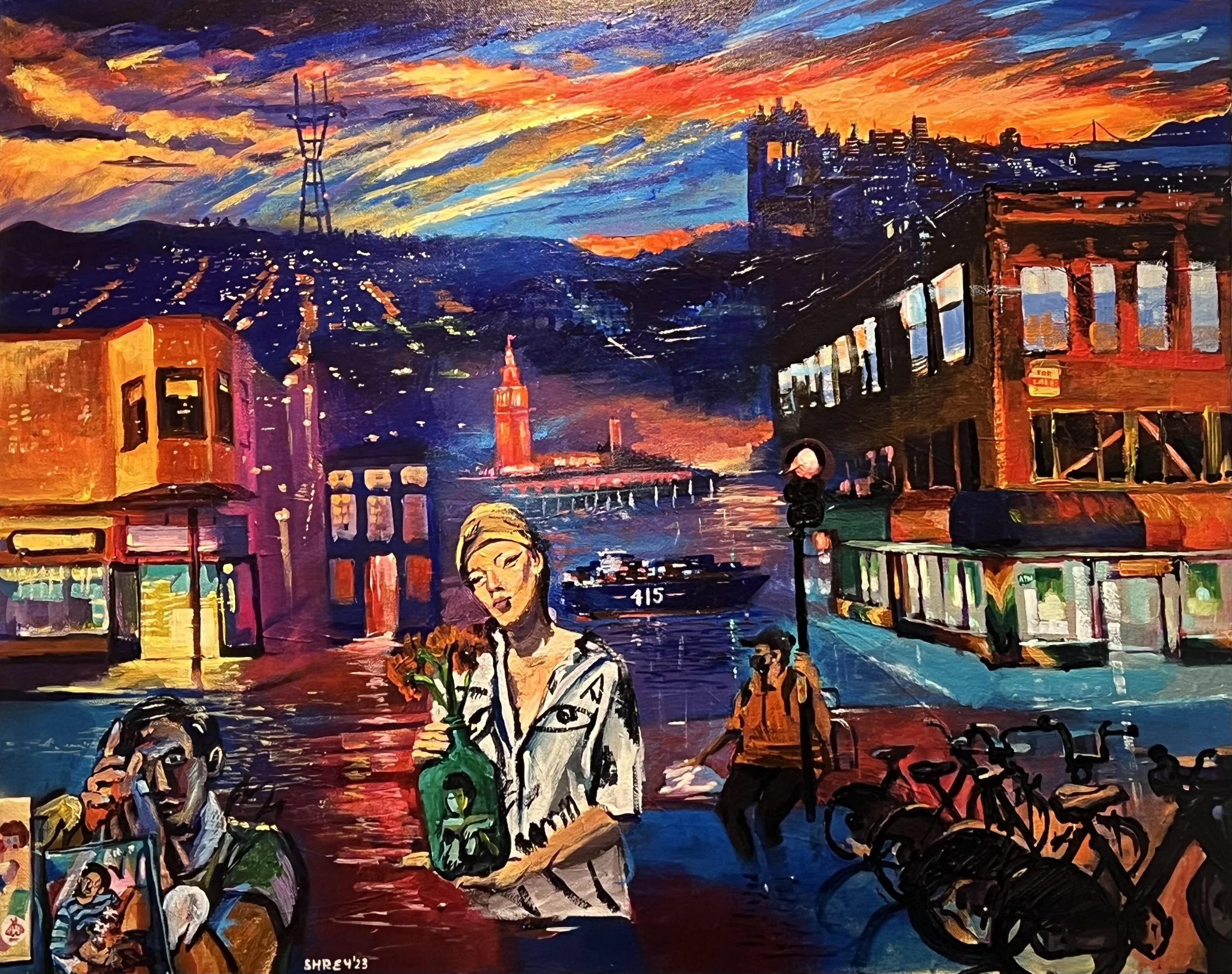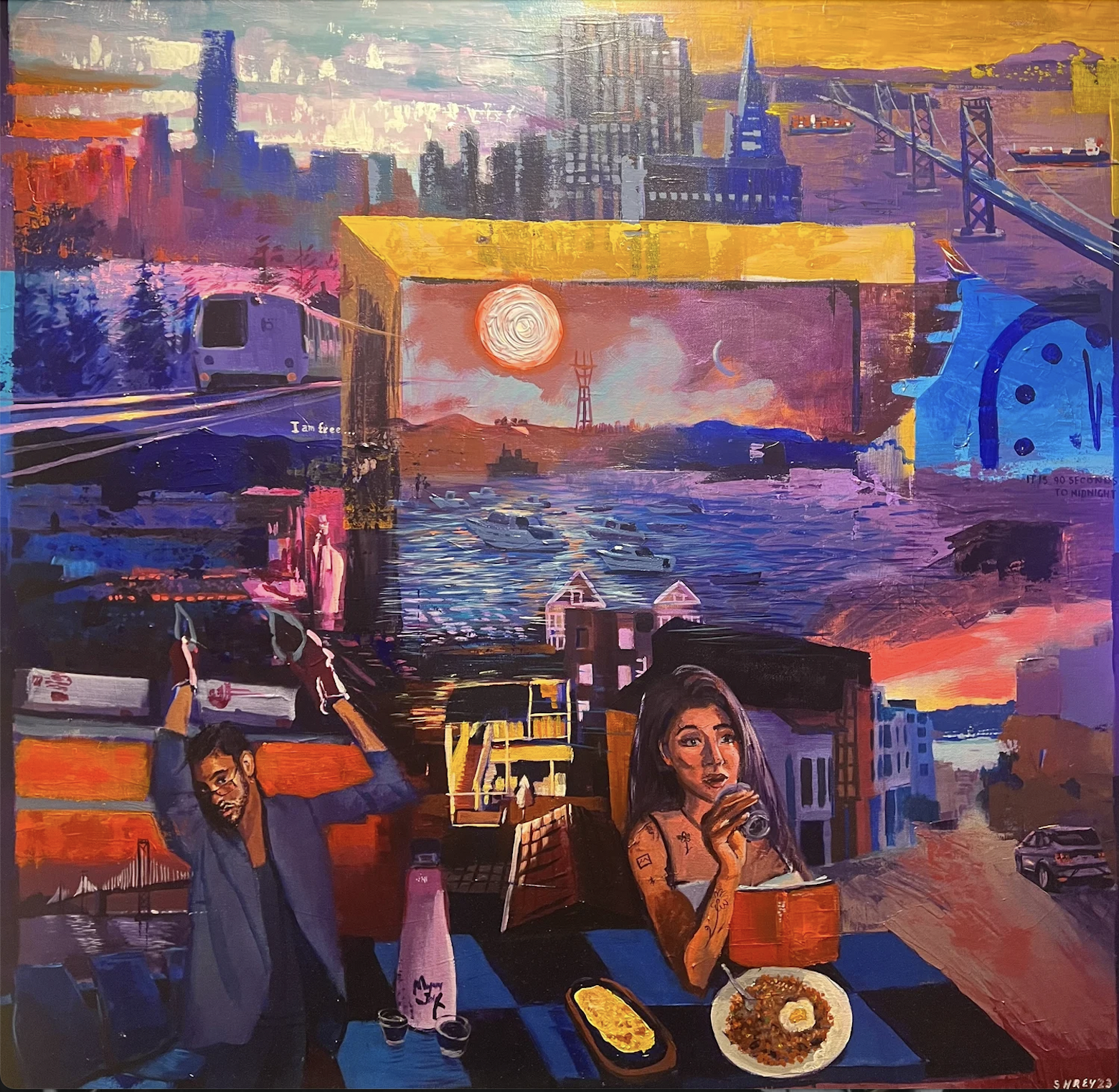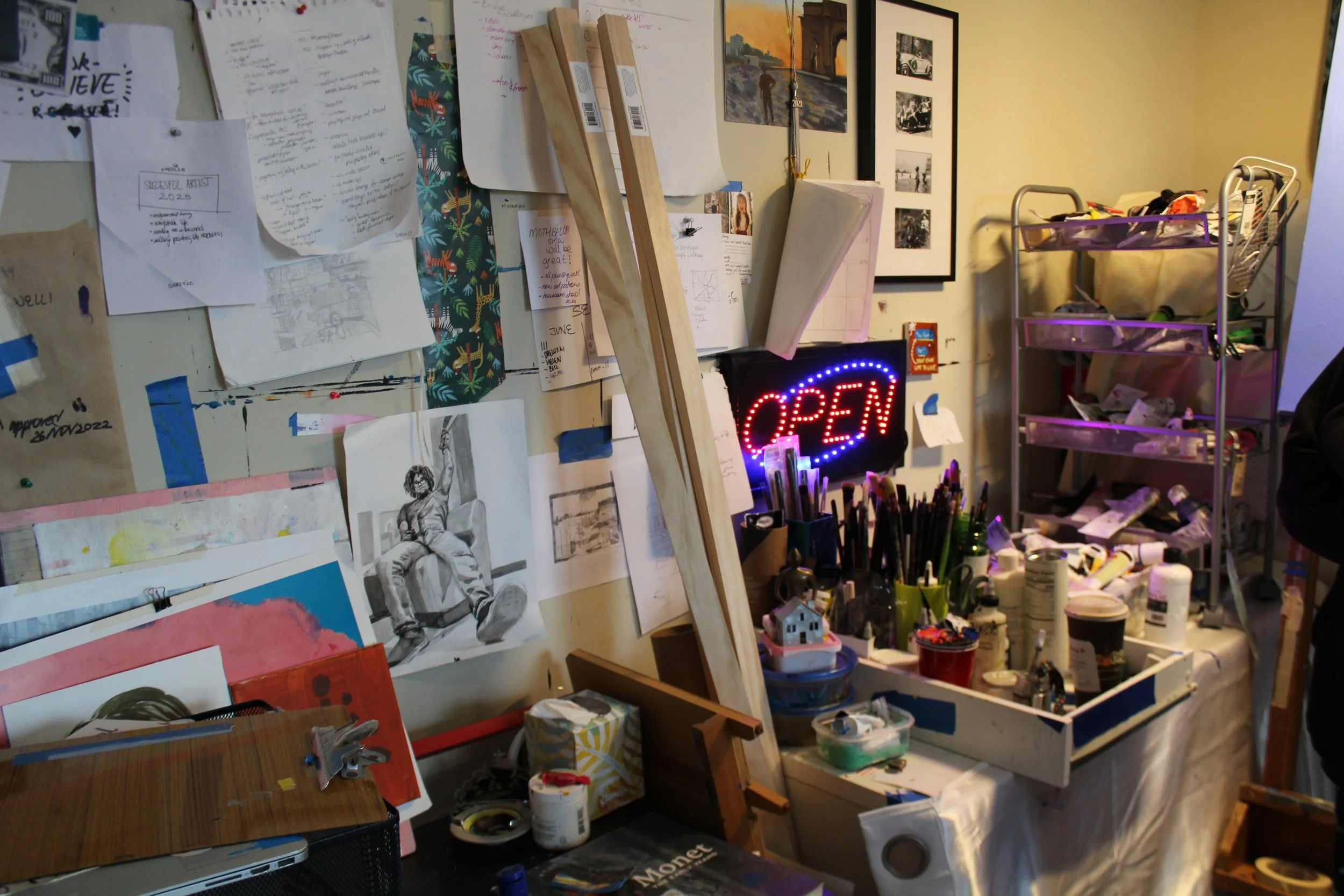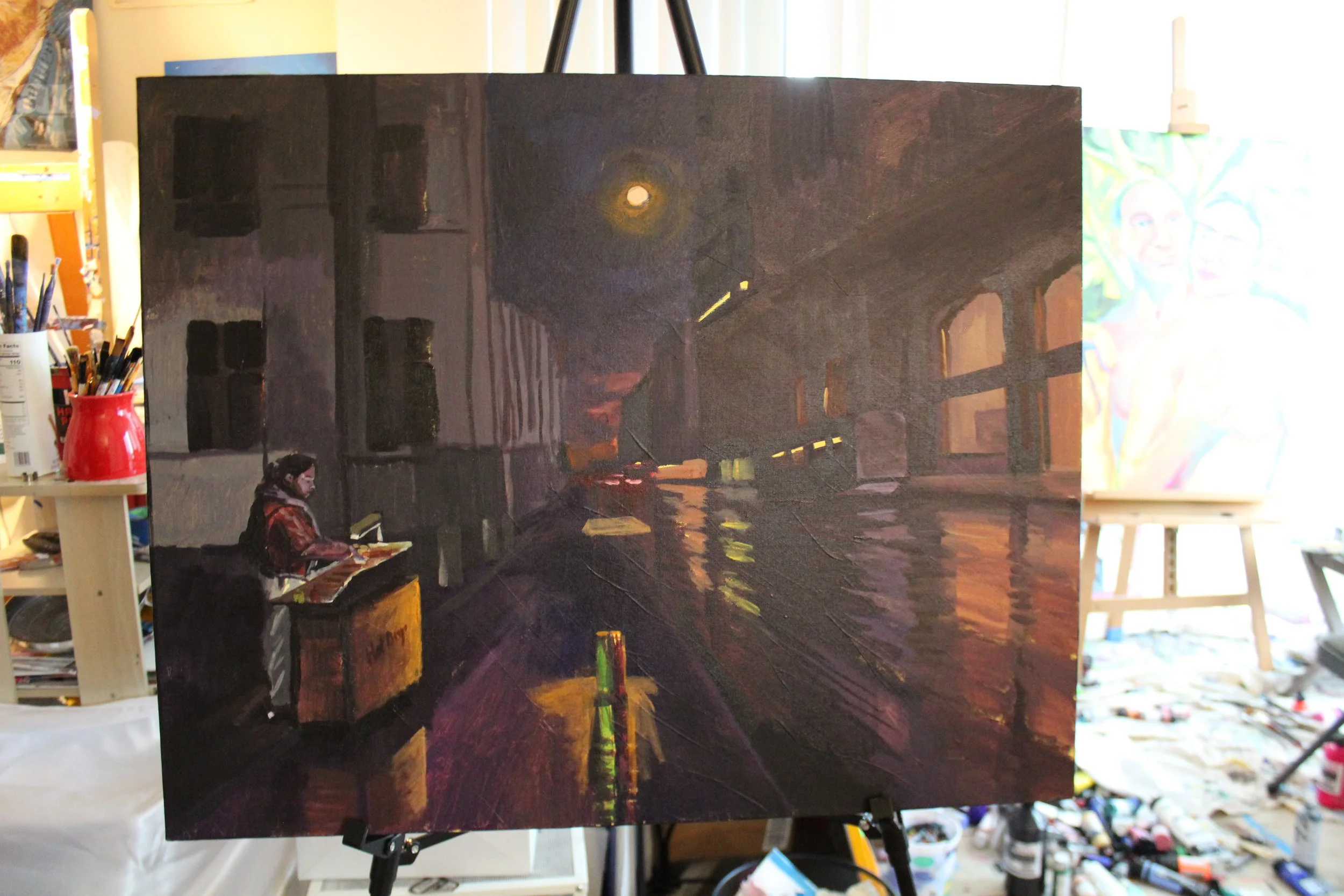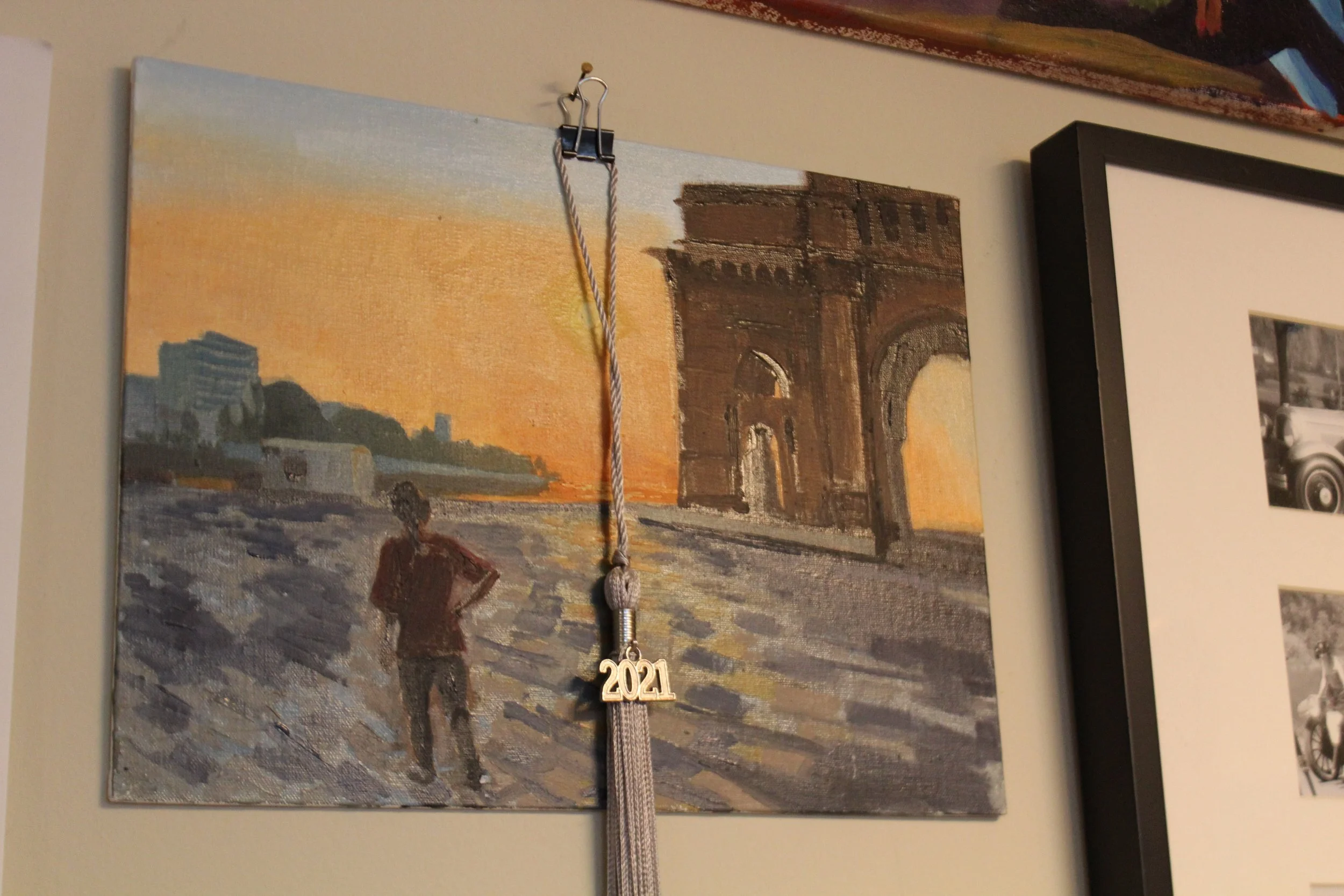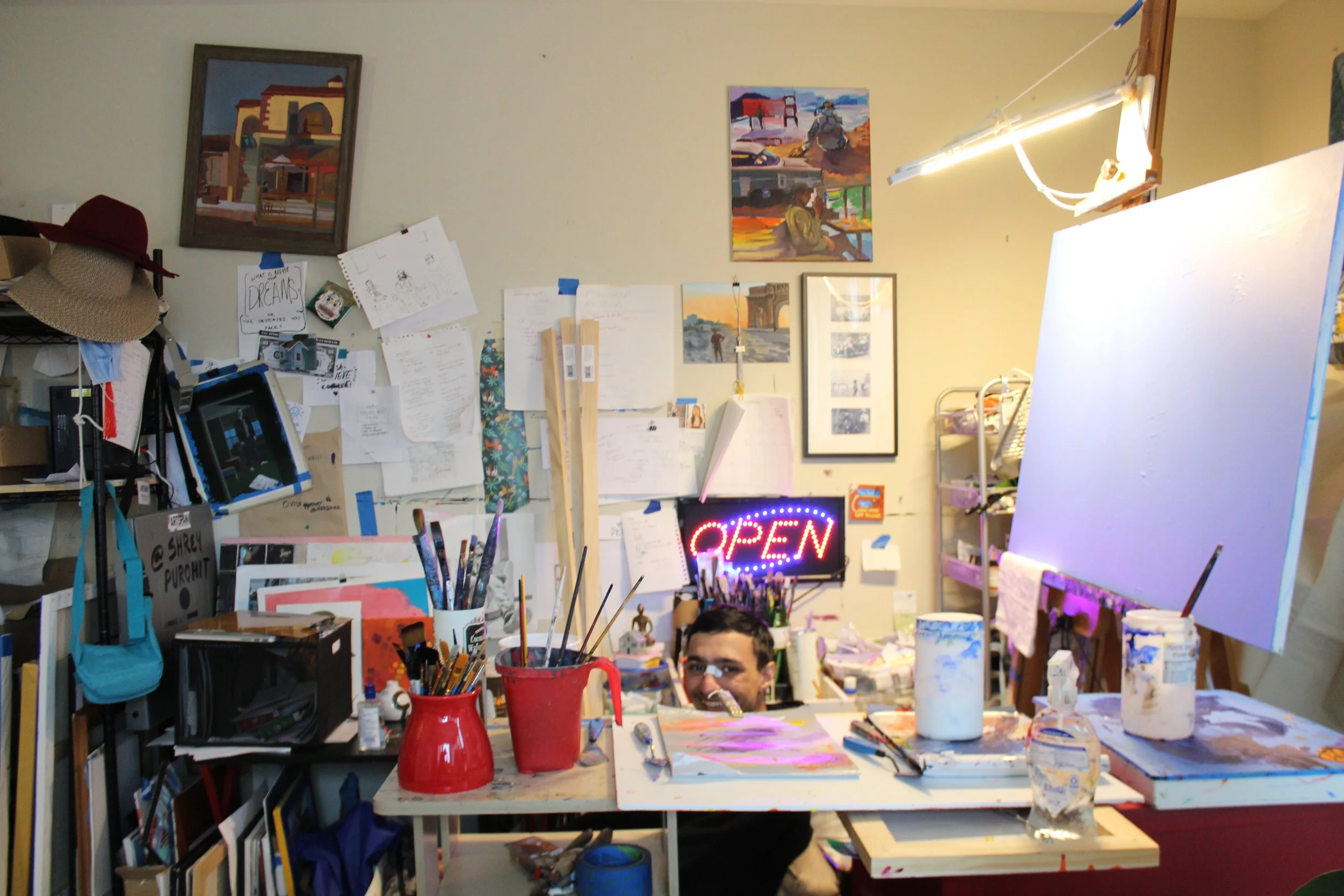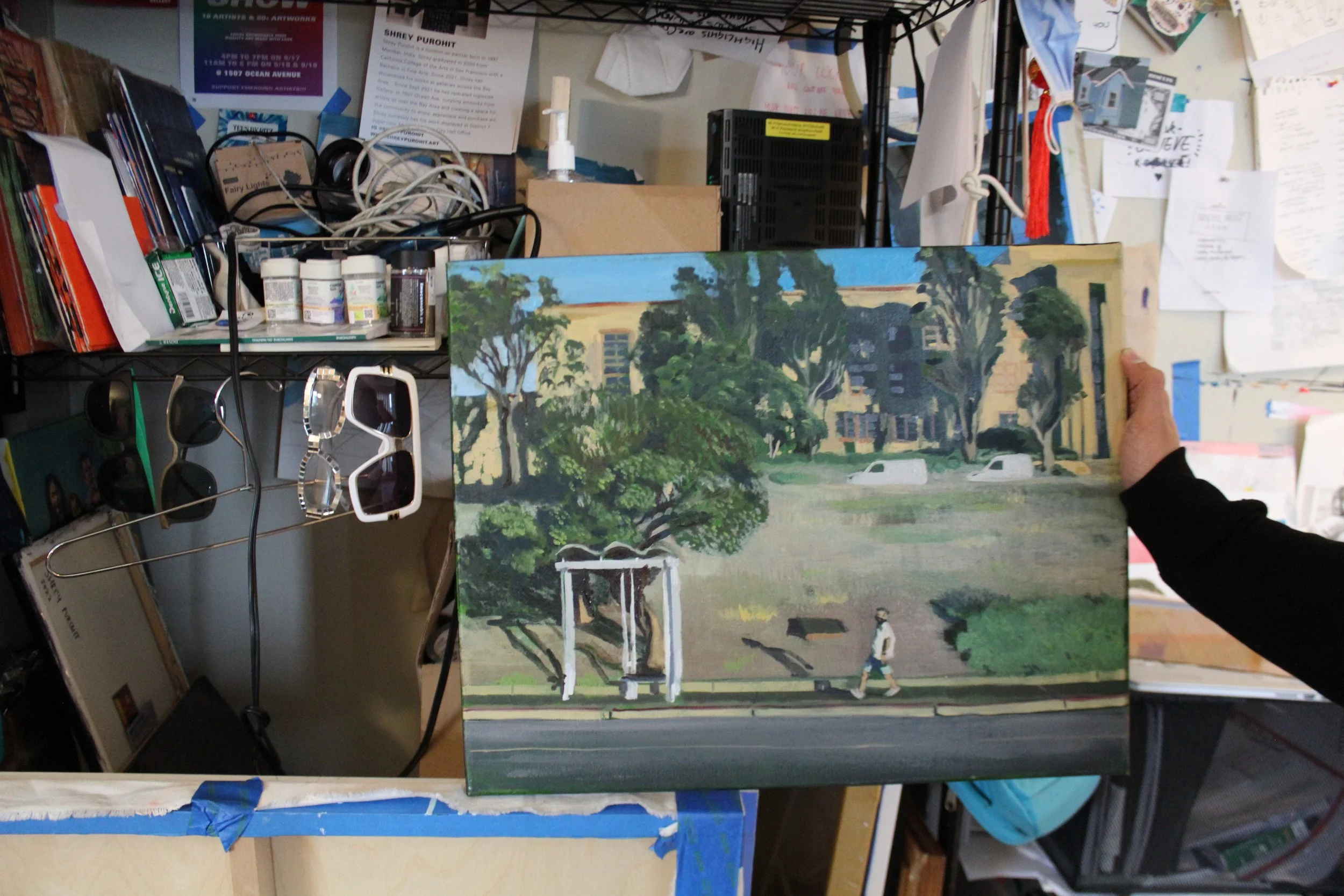Studio Visit & Interview with Shrey Purohit
By Jes Distad
Shrey Purohit is a multi-disciplined artist and activist located in the wildly wonderful Ingleside neighborhood of San Francisco. His name, Shrey, literally means authorship. From the moment his parents named him, he has been destined to create art. When he’s not busy painting landscapes, he spends time supporting other artists.
As someone who is also a community activist, I could tell from the moment I met Shrey that he genuinely cares. You can give people all the tools in the world, but it’s so hard to convince someone to care if they don’t, and it’s so rewarding to find someone that does. Like a rainbow – a Shreynbow, if you may.
When I arrived at his studio, Shrey told me the most delightful stories: about the family that owns the burger restaurant across the street, the handyman in his building who is secretly an amazing musician, the folx that work at the coffee shop next door, and so many more. At the heart of all those stories were authentic connections. He has an understanding that our humanity shines when we share a deep empathy with each other, and I think it’s one of his most admirable qualities as a human but also as an artist.
Even if you’ve never met him, chances are Shrey is rooting for you. If you’re an artist, chances are Shrey is hyping you up. I recently had an opportunity to visit Shrey’s studio, and from the moment I arrived, I could feel the warmth and creativity that his studio emanates. Inspirational messages and maxims are pinned to the walls. His studio is decorated with his own work and work from friends.
Some of Shrey’s work is currently on display in Moth Belly Gallery’s show The City That Knows How, open now through the end of February, 2023. For any inquiries about the exhibit and the work available, please email mothbellygallery@gmail.com
Interview
Hi Shrey! Thanks for letting me come take a bunch of pictures in your studio and talking to me about your art. For those that don't know you, can you tell us a little bit about who you are and what type of art you make?
Hey! Im Shrey Purohit. I was born and raised in Mumbai, India. I came to the US in 2018 to attend the illustration program at CCA. I graduated in the thick of the pandemic at the end of 2020. I look for beauty in my local neighborhood and have been creating paintings with the intent to share and connect with my neighbors. In mid 2021, after receiving recognition from the local newspaper Ingleside Light, neighbors began taking interest in my work and with the encouragement of District 7 supervisor Myrna Melgar, I was emboldened to bring the community of local artists and art lovers together. I founded and curated group shows at Ingleside Gallery— focusing on creating opportunities for emerging artists to display and sell their art.
My art practice is based in painting and capturing urban landscapes. Capturing people, places and things in my paintings is my way of seeing, reflecting and acknowledging our collective teamwork as humans. The current series I’m working in, “Collage Surrealism”, is primarily acrylic and mixed media works on canvas. Layered like a dreamscape, the compositions invite the viewer to explore the scenes at their own time.
Your collage style acrylic paintings at Moth Belly Gallery's current show “The City That Knows How” showcase some of San Francisco's most iconic landmarks paired with various people. What’s going on there?
The cityscape can be very awe-inspiring and yet deeply isolating at the same time. The scale of the city’s large structures and monuments can overshadow the humans that live colorful lives within it. Jun Yang, Bad Bunny, and Andrea Zamora are just a few humans that are featured in my paintings in this group show. A painter, a musician, and an actress to capture the range of artists. It was important to include figures in this work as it’s an homage, a dedication, and a display of my love and gratitude to be inspired by them. There’s a painting in the show that is my favorite, “It Takes An Entire City To Build Artistic Bridges.” It is a self-portrait, capturing myself as kid with my grandfather, myself as an 8 year old, and me as a 25 year old. I miss my grandfather. He passed away when I was 15. It was his dream to move abroad, but he chose to support his parents, wife and kids. Almost a century later, I’m able to move to San Francisco and build my life here. These 3 portraits are set on the background of the Golden Gate Bridge being built from 1933—a recognition that this magnificent bridge was once baby-like, built by thousands of humans and with the support of the city, state, and federal governments. Likewise, I’m the baby, being built to connect people. As a curator I feel my role is to connect communities of artists with art lovers. Lastly there is a small icon of Hamilton The Musical with a full-finished Orpheum Theater in the painting. I love the American experiment in democracy and I value its existence. It’s not perfect at all, but there is within it a hope for a more perfect union.
“Glimpses of the 415”, 24”x30” Acrylic on Canvas. Part of the exhibit The City That Knows How.
Can you tell us more about your transition from Mumbai to the US, and how it's helped shape your art?
I came to San Francisco with the motivation of learning and creating a flourishing life. In Mumbai, I was a self-taught graphic designer and was running a graphic design studio, until closing it in 2017. I looked at opportunities to up my skills. I had been to SF as a kid and had fond memories of the city and its views. The community of creative and smart individuals all in the same geographical area, and the access to nature and the ocean drew me in. One thing I was most excited by was the Bay Area’s historic culture that welcomes immigrants with ideas and desire to work.
I bring my cosmic perspective of the world from the teaching of Bay Area philosopher Alan Watts. I felt a deep connection to him being here half a century ago. His teachings on Hinduism, Zen Buddhism and Taoism influence my meanings of life.
You've also studied at CCA and were an illustrator. Can you tell us about your academic journey from illustrator to landscape artist and oil painter?
The first two years of CCA I felt political illustration was my path, I pursued making editorial illustrations and made connections with local politicians and congress people. I was welcomed, however I still felt weird and like an outsider. My opinions would be dismissed after finding out I wasn’t a citizen of the US. When I graduated in December of 2020, in the midst of the pandemic, I was looking for a silver lining and reasons to be hopeful. Documenting the public space we share was one way I began that journey. Living on Potrero while in art school, I would frequent the coffee shop as a refuge and draw the interiors or people sipping their beverages. This was a way to escape the assignments from the illustration world. Now, since 2020, I have developed a way of looking at urban surroundings from micro to macro perspectives. Informed by my love for political science and history, now in my collage series I’m able to combine my painting with politics. Sometimes obviously and other times more hidden in my work.
You mentioned buses and trains are important to you and your work. Can you tell us more about that?
Teamwork and community make this world possible. I love buses and trains; they are such symbols of society working together. Modern American culture celebrates hyper individualism. Most of us know no one is self-made. It took so much hard work, dedication, determination, and ingenuity from so many billions of humans for me to be a painter. From the paint supplies, to my food, to the roof I sleep under—all made, created, and shared by humans other than myself. Even the phone I use, the shoes I wear, the food I eat. What is the meaning of life? Community and teamwork! I’m so grateful to have the public transportation that San Francisco has—it has its fair share of problems but it’s the people’s car, and a public space we all share and have access to. And not to forget the climate crisis which our generation and our kids will have to face.
“Andrea & Benito”, 36”x36” Acrylic on Canvas. Part of the exhibit The City That Knows How.
In the grand scheme of things, we humans built all this technology, to help each other. From the wheel to mobile phones, computers, cars, to this big Muni bus from resources meant for everybody. However, in capitalism are they shared equitably? Nope, there is a wall with a price even for ground water bottles in plastic. There is an interface of corporations whose motive is to accumulate as many digits in their bank accounts as they can. In contrast, the bus, a public mode of transportation, which costs a million dollars to purchase and operate provides so many humans the service of mobility. In my opinion, it deserves equal if not more love than we give to fancy million-dollar cars which serve one human.
Light is also such an important part of your work. How has it come to be one of your primary subjects?
To me the ultimate gift of life is in our ability to see. The light from the Big Bang that created this universe! I’m painting the light recognizing our cosmic connection. I’m grateful us humans exist right now; it took 15 billion years of evolution to get here. I like to focus on the larger context of this subject, like it is fascinating to me that we have light that comes to earth from millions of miles away. All in the span of 8 minutes, it travels from the sun to our eyes. This universe and existence are so magical; surviving the burdens of rents, egos and greed can rob us of the real meaning of life: we as humans have all we need, our ancestors did so much work for us to finally create a better present and future. We’re descendants of the Big Bang, we can do anything we set our minds to. Teamwork makes the dream work, that’s the only way things have ever gotten done. The magical thing about us humans is our ability to imagine something and make it happen!
Also, I’m sucker for dramatic scenes, inspired by Caravaggio and Hopper.
Something I admire about you is your passion for advocacy work and how you truly care about people. How does that translate into your art?
Thank you, I’m grateful I have the privilege, and as a human with so many resources it’s my duty to share and advocate for my fellow humans and artists with my words, thoughts and feelings. It translates into my art, in capturing the moments of awe I feel with this landscape—like the views of the city lights glimmering like stars in the sky. I’m moving towards having more of the mundane scenes from my life transformed to be extraordinary—as life is. My favorite people and places that catch my eye or that I spend time with end up in my paintings. I am a product of my upbringing and my environment. I’m always looking to meet new people and artists, it enhances my view on humanity.
You and I both were both inspired by the work of Edward Hopper. Can you tell us more about how he inspired you and who some of your other inspirations are?
I love and adore Edward Hopper’s work and the way he captures New York of the 30s and 40s. Capturing the quiet scenes of human existence—through his lenses. Hopper painted his bubble utopia and saw the world thru his ego. I love his wife Jo’s paintings. The light on the buildings sometimes has an unreal or artificial feeling and even though called a realist, Hopper’s paintings have more conceptual and hidden meanings to them.
I know you work en plein air quite a bit. How does that compare to your work in the studio?
Early in the pandemic I began the practice of plein air painting, going out with oil paint and a French easel, and doing it almost every day for months. Then going out and painting with my friends Mila Kirillova, Nathaniel J Bice and Nathalie Lenderman over into 2022. The on-site studies Inform my studio practice, enabling me to bring the feeling of a location and to capture its energy.
Follow up to that, to find your groove in the studio, what rituals or comforts do you seek to get into your groove?
Hehe. I have many substances I tap to elevate my painting experience—Bad Bunny, political news, art history audiobooks, spicy mango lemonade, or spicy ginger shots, chocolate wafers, hot tea. Access to the kitchen has become so important to my practice. I was so into the idea of starving artists this year—however these paintings in the exhibit were made with a satisfied tummy and that made all the difference.
Anyone that has met you knows you are infectiously optimistic. How does your art help shape your positivity?
Hehe thank you. We’re all on this earth for a limited time, the loss of my grandparents and aunt in the last few years catalyzed my need to share with all my heart. With my art, I’m pointing out to spots and saying “look how beautiful this spot is juxtaposed with another.” We’re so lucky to be alive, why not be the best and most uplifting person I can be?
“I’m Not Your Biscuit, AKA Bizcochito”, 24”x30” Acrylic on Canvas. Part of the exhibit The City That Knows How.
Lastly, is there anything else you want us know?
I’ve been supported by so many people; I want to thank all of them for my recognition. My parents, friends, neighbors all contributed to my paintings. Special thanks to Jun Yang, my studio mate, for his loving support and encouragement that has helped me push my work. A huge appreciation for Emily Fromm, John V and KT, I’m so touched and grateful for this opportunity. I remember coming to Moth Belly and looking at artist’s work and manifesting a show to share my perspective and here I am. I’m highly dyslexic so i want show that anythings possible. San Francisco is a hard place but being a genuine person and being persistent will take you a long way.


